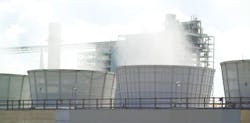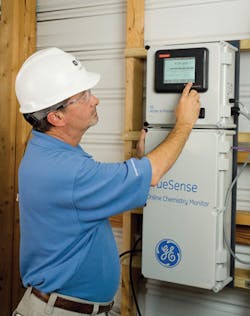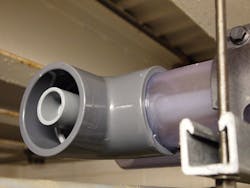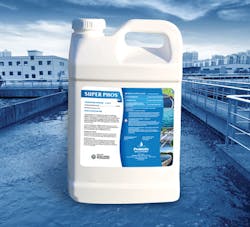By Art Haddaway
Many industrial processes today require large amounts of water to cool a variety of components and equipment. From petroleum refineries to manufacturing sites to electric power plants, utilizing this water to remove or transfer heat from critical systems can lead to several advantages that involve reduced production costs, lower energy consumption and decreased environmental impacts, among others - all vital factors that help contribute to improving overall operation and productivity.
Carrying out these efforts, however, doesn’t come without its many challenges, particularly with regard to meeting stringent and ever-changing state and federal cooling water regulations. According to the Environmental Protection Agency (EPA), cooling water is necessary to chill heat-generating equipment or condense gases in a thermodynamic cycle, and much is required of these plants when it comes to managing the quality and quantity of this water.
EPA indicated that over half of all water withdrawn each year in the U.S. is used for industrial cooling purposes. In fact, it noted that thermoelectric generation serves as the largest consumer of this water, while other sectors such as aluminum, chemicals and allied products, food and kindred products, pulp and paper, refined fuel products, and steel also use it extensively. Further, one of the most water-intensive methods used in these applications is once-through cooling, where water contacts and lowers the temperature of a heat source and is then discharged.
Given this high volume of intake and discharge, specific standards are essential to ensure the proper protection of water and the environment, in addition to the site itself. These are addressed in the National Pollutant Discharge Elimination System (NPDES), Clean Water Act (CWA) and other critical permit programs that help monitor water pollution at different point sources throughout the nation. In recent years, some industrial cooling water regulations have been revised and are continuing to be improved in light of ongoing bacterial outbreaks, such as Legionnaires’ disease bacteria (LDB) growth, and to accommodate ever-changing demands within the industry.
The Occupational Safety and Health Administration (OSHA) explained that cooling systems “should be properly monitored and maintained according to manufacturers’ recommendations to prevent buildup of scale, sediment and biofouling.” Likewise, it stated that “visual inspection and periodic maintenance of the system[s] are the best ways to control growth of LDB and related organisms,” and regulations such as EPA’s CWA 316(b) Existing Facilities Rule, or Cooling Water Intake Rule, for example, are helping facilities achieve these goals.
In August 2014, EPA finalized its CWA 316(b) rule, which provides guidelines for the design and operation of cooling water intake structures in order to prevent or reduce adverse impacts to the site, local economy and mainly the environment as it pertains to marine life. Given that large populations of fish and other aquatic animals can get trapped within these intake systems - potentially corroding equipment and even contaminating the water - the Agency’s rule protects these species while benefiting the site itself.
The EPA explained that the statute applies to plants that withdraw more than 2 million gallons of water per day from certain source waters, have an NPDES permit and use at least 25 percent of the water for cooling purposes. Further, the Agency has projected that a total of 1,065 facilities will be subject to the final rule, including 544 electric generators, 509 manufacturers in six primary manufacturing industries, and 12 manufacturers in other industries.
“EPA estimates that the final rule will achieve monetized benefits to society of $29-33 million annually, depending on the discount rate,” an EPA spokesperson explained. Likewise, this also involves reducing “greenhouse gas emissions by 9.3 million tons of CO2-equivalent emissions over the next 40 years,” he said. “By setting flexible technology standards, EPA’s commonsense regulations will greatly reduce damage to ecosystems while accommodating site-specific circumstances and providing cost-effective options.”
Other relevant industrial cooling water strategies are outlined in EPA’s updated Effluent Guidelines, which comprise national technology-based wastewater discharge standards that are developed on an industry-by-industry basis and represent the greatest pollutant reductions economically achievable for an industry. This includes the Petroleum Refining Effluent Guidelines, which focus on once-through cooling tower water at petroleum refineries to prevent buildup of dissolved solids. EPA is currently conducting a detailed study to consider revising the rules, which cover discharges at over 140 refineries across the country.
In an effort to better meet these myriad regulations and fully optimize overall efficiency, industrial plants utilizing cooling water should be taking proactive measures to implement and maintain an effective system/tower. The main factors in achieving this involve maintaining consistency of water temperature, flow level and purity, in addition to reinforcing continuity of biocide use, cleaning/sanitation and record-keeping/water sampling, as recommended by OSHA.
According to a recent report from Nalco, an Ecolab company, “Most industrial production processes need cooling water for efficient, proper operation … [and] all rely on the cooling water system to do its job. The total value of the production process will be sustained only if the cooling system can maintain the proper process temperature and pressure.” Further, it stated that “the cooling system design, effectiveness and efficiency [also] depend on the type of process being cooled, the characteristics of the water and environmental considerations.”
Ultimately, these objectives can be fully realized by incorporating a variety of innovative tools and technologies that help industrial plants improve their efforts in the areas of water treatment, operations management and regulatory compliance. Companies such as Dow Water & Process Solutions and GE Water & Process Technologies, for example, have contributed to this trend and are continuing to innovate and provide their expertise in this field.
With regard to cooling and heat transfer, many problematic water-related issues - including organic pathogens, scale and biofilm formation, soluble buildup, and more - often arise and can cause a variety of challenges affecting critical industrial processes. As such, Dow offers a wide range of advanced solutions such as its FILMTEC, DOWEX, AMBERLITE, and DUOLITE units encompassing reverse osmosis, ion exchange, nanofiltration, demineralization, and antiscalants, among others.
“We have a broad array of technologies for cooling tower treatment,” said Tracy Young, a senior associate R&D director with Dow. “People are looking at how they can improve their operations in order to be water efficient so they can grow. When you look at the amount of water that’s used in cooling (and where the industry is located), there will be a need to be more water efficient, so that’s an overarching trend.”
Likewise, heavy water withdrawals and their effect on industrial operations and water resources have also posed an ongoing challenge for plants utilizing cooling water services. With that, GE provides a number of solutions such as its GenGard, TrueSense, Spectrus, and DeposiTrol units concentrating on pre-cleaning, recirculation, remote monitoring and diagnostics, and intake control, in addition to others.
“Our strategy has always been to help customers focus on water management, reduce the water that’s used on site, and reuse the water that’s used within the site,” said Peter Macios, executive product manager for GE. “What we’ve allowed the plants to do is not only get into regulatory compliance from an environmental perspective but also to reduce operational costs.” As a whole, there are a number of effective measures that industrial plants can adopt to ensure that a cooling tower system is operating in a water-efficient manner. At a minimum, the Alliance for Water Efficiency suggests a system should have a dedicated water meter that is read daily by the local maintenance staff, and a TDS meter/controller to maintain proper bleed-off rates. The organization further recommends that acid treatment controllers and filtering equipment can greatly reduce water use while properly maintaining the equipment.
Thermoplastic Piping Lowers Paper Plant Operational Costs, Ensures Safety
Paper manufacturers rely on piping systems to convey sodium hypochlorite (NaOCI), or bleach, to whiten raw paper. Ensuring the safety of their employees, equipment and the environment while handling NaOCI and other caustics, is a major concern.
One paper manufacturer was experiencing leaks so frequently from corroded welds in its stainless steel Schedule 40 316L piping system that they were having to replace it every five years - an extremely costly recurring expense. Management sought a better solution.
The pressure rated Double-See™ Double Containment corrosive waste piping system in PVC Schedule 80 from GF Piping Systems was chosen to replace the stainless steel system.
“Management wanted a safe system, but if they had to replace it every five years, they wanted a system that would be more economical,” said Doug Winkler, South Central area sales manager of engineering piping for GF Piping Systems. “The Double-See PVC system is about half the cost of stainless steel and they were willing to try it.”
About 2,500 feet of Double-See piping was installed both inside and outside the plant and transports the NaOCI at about 50 PSI. During the process, NaOCl is exposed to a wide range of temperature elements from summer heat to cold winter.
Since the Double-See installation in March 2013, the system has run at or above expectations and has proven to be the solution management had hoped for. With that success, the paper manufacturer plans to retrofit the entire NaOCl system site-wide with Double-See as well as additional systems that transport less caustic chemicals.
Maximizing Phosphorous Bioavailability Delivers Big Benefits
A pulp and paper client in Wisconsin reduced its daily wastewater treatment phosphoric acid use by over 80 percent - along with saving multiple man-hours and improving safety due to reducing chemical handling time.
Super Phos® from Probiotic Solutions is designed as an ultra-efficient bioavailable source of phosphorus for microorganisms in wastewater. It’s created with a proprietary Micro Carbon Technology® (MCT) that complexes very small, highly refined carbon molecules to serve as a carrier for macro- and micronutrients. These carbon molecules enable more efficient nutrient absorption, greatly enhancing existing microbial activity and efficiency in industrial wastewaters.
Even with the reductions in chemical addition, the paper manufacturer’s wastewater treatment plant continues to perform well in meeting strict compliance regulations. As phosphorus limits are becoming stricter, reduction in effluent phosphorus levels is an additional key benefit.
To learn more about how Super Phos® brings these benefits to many mills across the globe, visit http://probiotic.com/case-studies.






